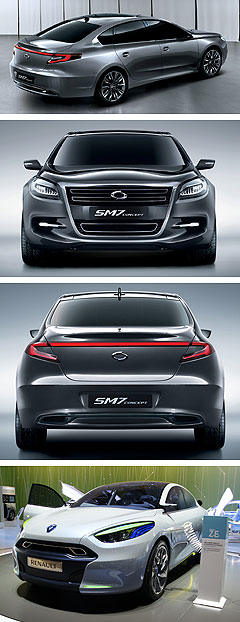Seoul show: Samsung’s SM7 large sedan laid bare
BY TERRY MARTIN | 1st Apr 2011

The flagship D-segment model is the latest vehicle to be developed in collaboration with the Renault-Nissan alliance, with the company describing the design concept as a ‘Man in Tuxedo’.
Confirming the impressions of a much more modern and sleeker look gained from the teaser sketch issued last week, the redesigned SM7 has emerged with a long, flowing silhouette, tapered roofline, narrow glasshouse and aggressive front-end treatment complete with an Audi-esque single-frame grille and large lower air intakes incorporating LED daytime running light strips.
The widespread use of LEDs across the vehicle is particularly striking at the rear end, running in a line between the crochet-needle-shaped light clusters.
Other features that draw attention include a prominent boot-lid spoiler and large 10-arm double-spoke alloy wheels wrapped in low-profile Hankook tyres.

Official details are scarce at this stage, with the new-generation SM7 understood to be built off a stretched platform that underpins the medium-sized Samsung SM5/Renault Latitude. The latter will be launched in Australia later this month.
Renault Samsung Motors CEO Jean-Marie Hurtiger said at this week’s show that the redesigned SM7 was on track to enter production in the second half of 2011, despite component shortages after the March 11 earthquake in Japan.
Renault Australia increasingly sources its vehicles – including the Latitude, Fluence small sedan and Koleos compact SUV – from South Korea, which is a cheaper source than Europe.
However, the company is still to confirm if it will broaden its range here with the SM7.
The current SM7 was released in South Korea in 2004 and is based on Nissan’s J31 platform that also underpins the Nissan Maxima and, in Asian markets, the Nissan Teana.
Renault Samsung also used the Seoul show to unveil a localised version of Renault’s Fluence ZE electric car, the SM3 ZE, and Nissan’s two-seater Twizy ZE concept.
Significantly, Samsung confirmed that the SM3/Fluence ZE was scheduled to enter full-scale production alongside conventional-engine versions at its Busan plant in South Korea next year, paving the way for a potential Australian introduction inside the next 18 months.
European models will be built in Bursa, Turkey.
As with the Kangoo ZE, the production version of the ZE-branded (zero emissions) SM3/Fluence is almost identical to its conventional-engine counterpart, with the obvious exception of a battery charge flap located near the wheelarch on either side of the vehicle.
Tipping the scales at around 1540kg, the SM3/Fluence ZE has a 70kW/226Nm electric motor and a 22kWh battery (located behind the rear seats), offering a 160km maximum driving range and a 135km/h top speed.
Quoted recharging times are the between six and eight hours using a 220-volt household mains supply, although the vehicle is also compatible with 400-volt rapid-charge stations, which can cut down charging times to 30 minutes.
The vehicle is also designed with an easily removable battery, making it compatible with a battery swap system where available, such as in networks developed by Better Place.
Renault executives have previously described its forthcoming EVs, including the Fluence ZE and Kangoo ZE, as “perfect for Australia” but have openly criticised the lack of government incentives that it sees as necessary to kick-start an EV campaign here.